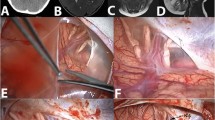Abstract
Purpose
The goal of this study was to investigate the mechanisms, diagnosis, and treatment of shunt dependency syndrome in patients with temporal lobe arachnoid cysts who were initially treated with cystoperitoneal (CP) shunting.
Methods
Thirteen patients with temporal lobe arachnoid cysts who had initially been treated with CP shunt placement and had developed shunt dependency syndrome were treated by the senior author at Tiantan Hospital between April 2010 and January 2012. The clinical manifestations, neuroimaging findings, intracranial pressure (ICP) data, treatment methods, and therapeutic results were reviewed retrospectively.
Results
The study included ten males and three females. The mean age at the time of development of shunt dependency syndrome was 12.3 years (range 5.5–24 years). In most patients, neuroimaging findings showed a collapsed cyst (the cyst appeared almost unchanged in only one patient) and normal or small ventricles (only one patient had enlarged ventricles). Three patients underwent simple replacement of the shunt, four underwent ventriculoperitoneal shunt placement, and the other six underwent lumboperitoneal shunt placement. All patients experienced resolution of their symptoms postoperatively. The mean duration of follow-up was 20 months.
Conclusions
Shunt dependency syndrome is a rare but serious complication of shunting an arachnoid cyst. This condition is similar to the slit ventricle syndrome, but also has some differences. ICP monitoring may confirm the diagnosis when there are no significant radiological findings. Achievement of a shunt-free state might be the ultimate goal for all shunted patients.




Similar content being viewed by others
References
Arai H, Sato K, Wachi A, Okuda O, Takeda N (1996) Arachnoid cysts of the middle cranial fossa: experience with 77 patients who were treated with cystoperitoneal shunting. Neurosurgery 39(6):1108–1112
Aoki N, Sakai T, Umezawa Y (1990) Slit ventricle syndrome after cyst-peritoneal shunting for the treatment of intracranial arachnoid cyst. Childs Nerv Syst 6(1):41–43
Ahn Y, Cho BK, Wang KC (1997) Bobble-head doll syndrome associated with subduroperitoneal shunt malfunction. Childs Nerv Syst 13(4):234–237
Bech RA, Juhler M (2000) Unusual clinical manifestations of disturbed CSF dynamics in hydrocephalic children. Childs Nerv Syst 16(7):446–449
di Rocco C, Velardi F (2003) Acquired Chiari type I malformation managed by supratentorial cranial enlargement. Childs Nerv Syst 19(12):800–807
Epstein FJ, Fleischer AS, Hochwald GM, Ransohoff J (1974) Subtemporal craniectomy for recurrent shunt obstruction secondary to small ventricles. J Neurosurg 41(1):29–31
Fang T, Yan R, Xing J, Li Y (2012) Slit ventricle syndrome after cyst-peritoneal shunting for the arachnoid cyst—a report of two cases. Clin Neurol Neurosurg 114(1):87–89
Fang T, Xu J, Wang S, Ma Z, Xing J (2010) Analysis of therapeutic choices for slit ventricle syndrome after cyst-peritoneal shunting for temporal arachnoid cysts in children. J Neurosurg Pediatr 6(5):474–480
Kim SK, Cho BK, Chung YN, Kim HS, Wang KC (2002) Shunt dependency in shunted arachnoid cyst: a reason to avoid shunting. Pediatr Neurosurg 37(4):178–185
Kishore PR, Rao CV, Williams JP, Vines FS (1980) The limitation of computerized tomographic diagnosis of intracranial midline cysts. Surg Neurol 14(6):417–431
Laviv Y, Michowitz S (2010) Acute intracranial hypertension and shunt dependency following treatment of intracranial arachnoid cyst in a child: a case report and review of the literature. Acta Neurochir (Wien) 152(8):1419–1423
Leo JS, Pinto RS, Hulvat GF, Epstein F, Kricheff II (1979) Radiology. Comput tomogr arachnoid cysts 130(3):675–680
Maixner VJ, Besser M, Johnston IH (1992) Pseudotumor syndrome in treated arachnoid cysts. Childs Nerv Syst 8(4):207–210
Mottolese C, Szathmari A, Simon E, Ginguene C, Ricci-Franchi AC, Hermier M (2010) The parallel use of endoscopic fenestration and a cystoperitoneal shunt with programmable valve to treat arachnoid cysts: experience and hypothesis. J Neurosurg Pediatr 5(4):408–414
Ruscalleda J, Guardia E, dos Santos FM, Carvajal A (1980) Dynamic study of arachnoid cysts with metrizamide. Neuroradiology 20(4):185–189
Shim KW, Lee YH, Park EK, Park YS, Choi JU, Kim DS (2009) Treatment option for arachnoid cysts. Childs Nerv Syst 25(11):1459–1466
Smith RA, Smith WA (1976) Arachnoid cysts of the middle cranial fossa. Surg Neurol 5(4):246–252
Sunami K, Saeki N, Sunada S (2002) Slit ventricle syndrome after cyst-peritoneal shunting for temporal arachnoid cyst in children—a clinical entity difficult to detect on neuroimaging study. Brain Dev 24(8):776–779
Zhang B, Zhang Y, Ma Z (2012) Long-term results of cystoperitoneal shunt placement for the treatment of arachnoid cysts in children. J Neurosurg Pediatr 10(4):302–305
Author information
Authors and Affiliations
Corresponding author
Additional information
Chunde Li and Luxin Yin are co-first authors.
Rights and permissions
About this article
Cite this article
Li, C., Yin, L., Jiang, T. et al. Shunt dependency syndrome after cystoperitoneal shunting of arachnoid cysts. Childs Nerv Syst 30, 471–476 (2014). https://doi.org/10.1007/s00381-013-2248-8
Received:
Accepted:
Published:
Issue Date:
DOI: https://doi.org/10.1007/s00381-013-2248-8




